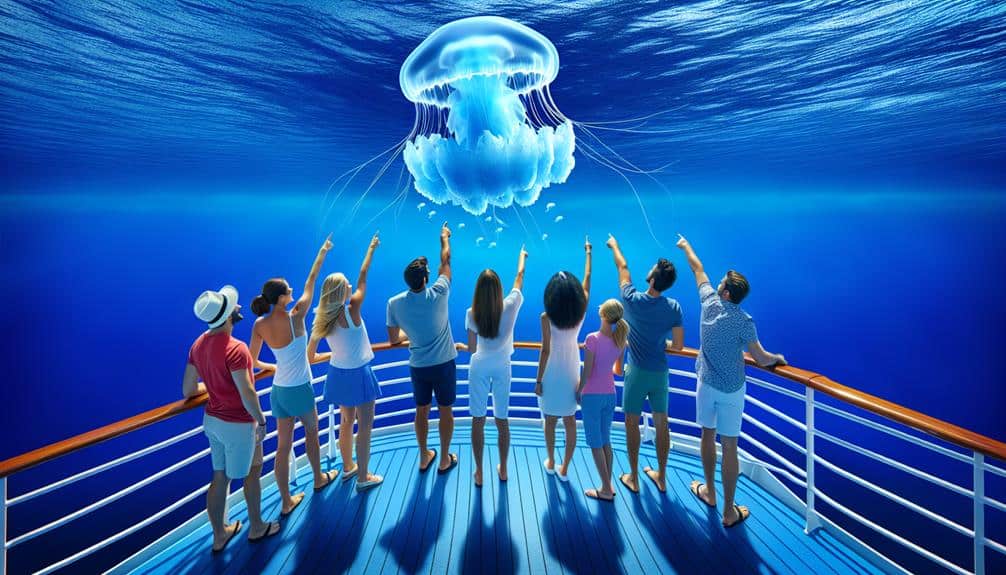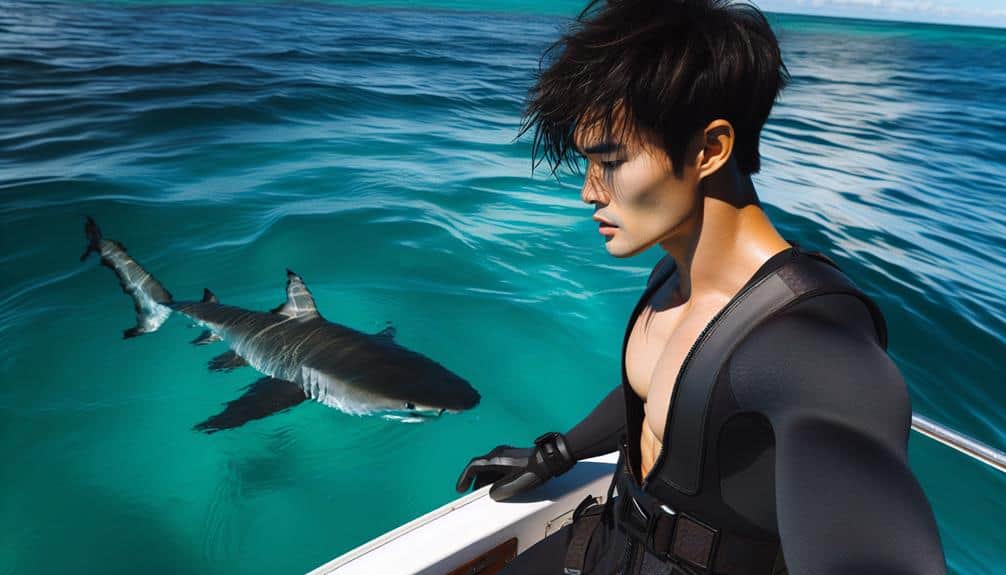Spotting rare jellyfish on cruise ship excursions? Look for Portuguese Man o' War with its blue hue and inflatable sail, and Pink Meanie with distinctive oral arms. In the Great Barrier Reef, watch out for box jellyfish and bluebottles. Palau's Jellyfish Lake is home to golden jellyfish. Safety tips: carry vinegar for stings and keep your distance. For photos, use natural light and a macro lens. Conservation efforts include research partnerships and educational campaigns. Make the most of your encounter by staying vigilant and appreciating the intricate beauty of these elusive creatures.
Key Points
- Look for Portuguese Man o' War and Pink Meanie jellyfish species
- Visit destinations like Palau, Great Barrier Reef, and Ogasawara Islands
- Carry vinegar for sting neutralization and maintain a safe distance
- Use natural lighting and a macro lens for photography
- Support conservation efforts through research and responsible tourism practices
Types of Rare Jellyfish to Look For
When setting off on cruise ship excursions to observe rare jellyfish, you should be on the lookout for distinct species such as the Portuguese Man o' War and the Pink Meanie. These jellyfish species possess unique characteristics that make them easily identifiable in the vast ocean waters.
The Portuguese Man o' War, although often mistaken for a jellyfish, is a colonial organism consisting of specialized individuals called zooids. Its vibrant blue color and inflatable sail make it unmistakable. On the other hand, the Pink Meanie, aptly named for its pink hue, possesses a large oral arm system that it uses to capture prey.
Identification techniques for these jellyfish species involve careful observation of their physical features. The Portuguese Man o' War can be identified by its gas-filled float and long tentacles that trail behind in the water. In contrast, the Pink Meanie displays a smooth, bell-shaped body with delicate oral arms. Understanding these distinctive characteristics will enhance your jellyfish spotting experience during your cruise ship excursions.
Best Cruise Destinations for Jellyfish
As you set sail on your cruise ship adventure in search of rare jellyfish species, consider exploring the top cruise destinations famous for their diverse jellyfish populations and stunning marine ecosystems.
Remote islands often hold hidden gems when it comes to jellyfish sightings. One such destination is Palau, a remote archipelago in the western Pacific Ocean. Here, you can encounter the mesmerizing golden jellyfish in the famous Jellyfish Lake, a unique marine site where these jellyfish have evolved without natural predators.
Another exceptional cruise destination for jellyfish enthusiasts is the Great Barrier Reef in Australia. This UNESCO World Heritage Site is home to a plethora of jellyfish species, including the box jellyfish and the iridescent bluebottle. The crystal-clear waters provide an ideal environment to observe these fascinating creatures in their natural habitat.
For a more off-the-beaten-path experience, consider cruising to the Ogasawara Islands in Japan. These remote volcanic islands are teeming with jellyfish diversity, offering a chance to spot rare species like the helmet jellyfish and the flower hat jellyfish. Explore these hidden gems for an unforgettable jellyfish expedition during your cruise.
Safety Tips for Jellyfish Encounters
To enhance your safety during jellyfish encounters, always carry a reliable source of vinegar to neutralize any stings swiftly. When identifying jellyfish, look for the bell-shaped body and tentacles that vary in length. Some species have vibrant colors, while others are transparent, making them harder to spot. It's important to keep a safe distance and avoid touching jellyfish, even if they appear harmless.
In case of a jellyfish sting, prompt first aid is essential. Rinse the affected area with vinegar to deactivate any remaining stingers. Avoid using freshwater, as it can worsen the sting. Remove tentacles with a pair of tweezers and apply a heat pack to alleviate pain. Seek medical attention if the symptoms persist or if you experience difficulty breathing.
How to Photograph Rare Jellyfish
For capturing stunning images of rare jellyfish, focus on utilizing natural lighting to highlight their intricate features and vibrant colors. When photographing these underwater beauties, consider the angle of the sun to maximize the light's reflection off the jellyfish's translucent body. Early morning or late afternoon typically offer the best lighting conditions for capturing moments of these mesmerizing creatures.
To showcase the jellyfish's unique details, use a macro lens to zoom in on their delicate tentacles and iridescent bodies. Adjust your camera settings to guarantee a fast shutter speed to freeze any movements and capture sharp images. Experiment with different depths of field to create striking compositions that emphasize the jellyfish against the blurred background of the ocean.
When composing your shots, pay attention to the jellyfish's natural movements and interactions with the surrounding environment. Be patient and observant to capture authentic moments that convey the essence of these fascinating creatures. Remember, the key to photographing rare jellyfish lies in understanding their behavior and translating their underwater beauty into enthralling images.
Conservation Efforts for Jellyfish Protection
Conservation initiatives play an essential role in safeguarding jellyfish populations and their ecosystems. Research partnerships are imperative for understanding jellyfish biology, behavior, and their role in marine environments. By collaborating with scientists and institutions worldwide, valuable data is collected to inform conservation strategies. These partnerships help identify threats to jellyfish populations, such as pollution and overfishing, allowing for targeted conservation efforts.
Educational campaigns are another crucial tool in jellyfish protection. By raising awareness about the importance of jellyfish in marine ecosystems, these campaigns foster a sense of stewardship towards these often-misunderstood creatures. Through outreach programs, workshops, and online resources, the public gains a deeper understanding of jellyfish and their ecological significance. Increased knowledge can lead to better conservation practices, such as responsible tourism guidelines to minimize disturbances to jellyfish habitats.
Frequently Asked Questions
Are There Any Specific Times of Year When Rare Jellyfish Sightings Are More Common on Cruise Ship Excursions?
During certain seasons, jellyfish sightings on cruise ship excursions become more common. Conservation efforts play an important role in monitoring and protecting jellyfish populations. Understanding these seasonal patterns is essential for ecotourism and marine conservation.
What Should I Do if I Encounter a Rare Jellyfish While Swimming or Snorkeling During a Cruise Ship Excursion?
If you encounter a rare jellyfish while swimming or snorkeling during a cruise ship excursion, stay calm. Remember emergency procedures. Utilize proper spotting techniques to avoid contact. Notify crew members immediately for assistance. Stay safe and aware.
Are There Any Restrictions or Regulations in Place to Protect Rare Jellyfish Populations in Popular Cruise Destinations?
To protect rare jellyfish populations in cruise destinations, regulations focus on conservation efforts, monitoring, and population dynamics research. Restrictions aim to preserve these delicate species, ensuring their presence for future exploration and study.
How Can I Differentiate Between a Rare Jellyfish Species and a More Common Jellyfish Species While on a Cruise Ship Excursion?
To differentiate between rare and common jellyfish species during a cruise ship wildlife spotting, focus on specific traits. Look at color patterns, tentacle lengths, and body shape. Use caution for safety and consult onboard guides or naturalists.
Are There Any Specific Behaviors or Movements That Rare Jellyfish Exhibit That Could Help Me Spot Them More Easily During a Cruise Ship Excursion?
To spot rare jellyfish on a cruise, observe their identifying features closely. They may use camouflage techniques, blending with surroundings. Look for unique movements or behaviors, like rapid pulsations or unusual tentacle patterns, distinguishing them from common species.



